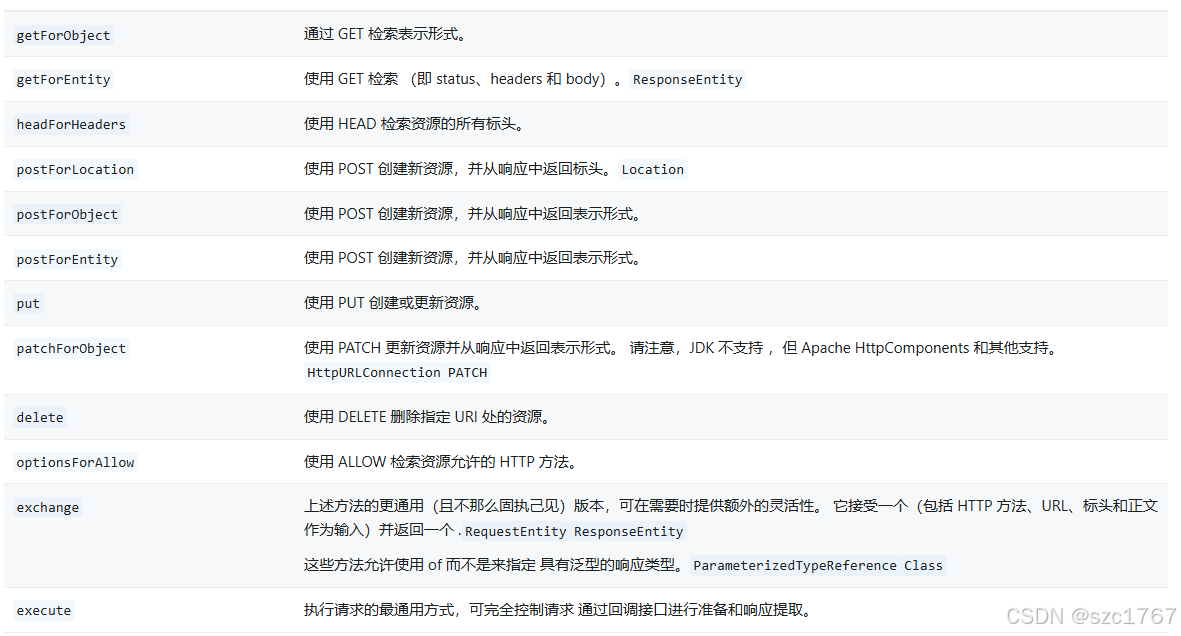简介
RestTemplate是一个执行HTTP请求的同步阻塞式工具类,它仅仅只是在 HTTP 客户端库(例如 JDK HttpURLConnection,Apache HttpComponents,okHttp 等)基础上,封装了更加简单易用的模板方法 API,方便程序员利用已提供的模板方法发起网络请求和处理,能很大程度上提升我们的开发效率
依赖
1、非Spring环境下使用RestTemplate
<dependency>
<groupId>org.springframework</groupId>
<artifactId>spring-web</artifactId>
</dependency>2、Spring环境下使用 RestTemplate
<dependency>
<groupId>org.springframework.boot</groupId>
<artifactId>spring-boot-starter-web</artifactId>
</dependency>初始化配置
@Configuration
public class RestTemplateConfig {
@Bean
public RestTemplate restTemplate(){
RestTemplate restTemplate = new RestTemplate(simpleClientHttpRequestFactory());
return restTemplate;
}
public ClientHttpRequestFactory simpleClientHttpRequestFactory() {
SimpleClientHttpRequestFactory factory = new SimpleClientHttpRequestFactory();
factory.setReadTimeout(150000); // ms
factory.setConnectTimeout(150000); // ms
return factory;
}
}这种初始化方法,是使用了JDK自带的HttpURLConnection作为底层HTTP客户端实现。
可以执行配置不同的连接方式,如
HttpClient
@Configuration
public class RestTemplateConfig {
@Bean
public RestTemplate restTemplate(){
RestTemplate restTemplate = new RestTemplate(getClientHttpRequestFactory());
return restTemplate;
}
/**
* 使用HttpClient作为底层客户端
* @return
*/
private ClientHttpRequestFactory getClientHttpRequestFactory() {
int timeout = 5000;
RequestConfig config = RequestConfig.custom()
.setConnectTimeout(timeout)
.setConnectionRequestTimeout(timeout)
.setSocketTimeout(timeout)
.build();
CloseableHttpClient client = HttpClientBuilder
.create()
.setDefaultRequestConfig(config)
.build();
return new HttpComponentsClientHttpRequestFactory(client);
}
}OkHttp
/**
* 使用OkHttpClient作为底层客户端
* @return
*/
private ClientHttpRequestFactory getClientHttpRequestFactory(){
OkHttpClient okHttpClient = new OkHttpClient.Builder()
.connectTimeout(5, TimeUnit.SECONDS)
.writeTimeout(5, TimeUnit.SECONDS)
.readTimeout(5, TimeUnit.SECONDS)
.build();
return new OkHttp3ClientHttpRequestFactory(okHttpClient);
}使用
restTemplate 提供的api

1、设置Header和 body
// 创建 HttpEntity
String jsonBody = JSONObject.toJSONString(weChatRefundsRequestDto);
HttpEntity<String> entity = new HttpEntity<>(jsonBody, headers);
ResponseEntity<WechatRefundsResponseDto> responseEntity =restTemplate.postForEntity("url",entity,WechatRefundsResponseDto.class);其中在entity 中设置请求头和请求体;WechatRefundsResponseDto为设置接受返回信息的对象,其他postObject 类似以上方式
public <T> ResponseEntity<T> postForEntity(String url, @Nullable Object request,
Class<T> responseType, Object... uriVariables) throws RestClientException其中postObeject,postForEntity的请求方式中的request如果类型为HttpEntity则直接使用,不是就将request当成body放入HttpEntity中使用
2、get请求设置带参数的请求
@Autowired
private RestTemplate restTemplate;
/**
* 单元测试(带参的get请求)
*/
@Test
public void testGetByRestFul(){
//请求地址
String url = "http://localhost:8080/testGetByRestFul/{1}/{2}";
//发起请求,直接返回对象(restful风格)
ResponseBean responseBean = restTemplate.getForObject(url, ResponseBean.class, "001", "张三");
System.out.println(responseBean.toString());
}
@Autowired
private RestTemplate restTemplate;
/**
* 单元测试(带参的get请求)
*/
@Test
public void testGetByParam(){
//请求地址
String url = "http://localhost:8080/testGetByParam?userName={userName}&userPwd={userPwd}";
//请求参数
Map<String, String> uriVariables = new HashMap<>();
uriVariables.put("userName", "唐三藏");
uriVariables.put("userPwd", "123456");
//发起请求,直接返回对象(带参数请求)
ResponseBean responseBean = restTemplate.getForObject(url, ResponseBean.class, uriVariables);
System.out.println(responseBean.toString());
}3、文件上传
@Autowired
private RestTemplate restTemplate;
/**
* 文件上传,post请求
*/
@Test
public void upload(){
//需要上传的文件
String filePath = "/Users/panzhi/Desktop/Jietu20220205-194655.jpg";
//请求地址
String url = "http://localhost:8080/upload";
// 请求头设置,multipart/form-data格式的数据
HttpHeaders headers = new HttpHeaders();
headers.setContentType(MediaType.MULTIPART_FORM_DATA);
//提交参数设置
MultiValueMap<String, Object> param = new LinkedMultiValueMap<>();
param.add("uploadFile", new FileSystemResource(new File(filePath)));
//服务端如果接受额外参数,可以传递
param.add("userName", "张三");
// 组装请求体
HttpEntity<MultiValueMap<String, Object>> request = new HttpEntity<>(param, headers);
//发起请求
ResponseBean responseBean = restTemplate.postForObject(url, request, ResponseBean.class);
System.out.println(responseBean.toString());
}4、文件下载
@Autowired
private RestTemplate restTemplate;
/**
* 小文件下载
* @throws IOException
*/
@Test
public void downloadFile() throws IOException {
String userName = "张三";
String fileName = "c98b677c-0948-46ef-84d2-3742a2b821b0.jpg";
//请求地址
String url = "http://localhost:8080/downloadFile/{1}/{2}";
//发起请求,直接返回对象(restful风格)
ResponseEntity<byte[]> rsp = restTemplate.getForEntity(url, byte[].class, userName,fileName);
System.out.println("文件下载请求结果状态码:" + rsp.getStatusCode());
// 将下载下来的文件内容保存到本地
String targetPath = "/Users/panzhi/Desktop/" + fileName;
Files.write(Paths.get(targetPath), Objects.requireNonNull(rsp.getBody(), "未获取到下载文件"));
}